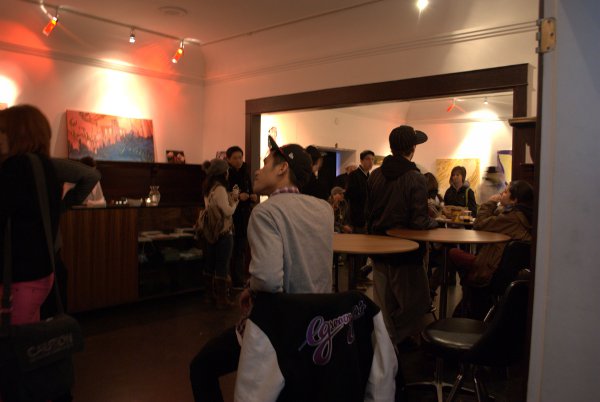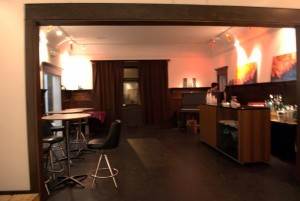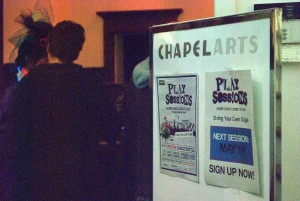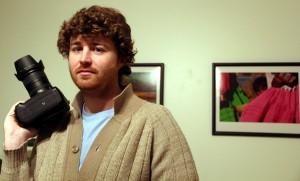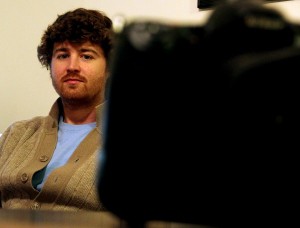Comedy goes unscripted at the Heritage Grill (with audio)
April 12, 2011 by Miranda Gathercole · Leave a Comment
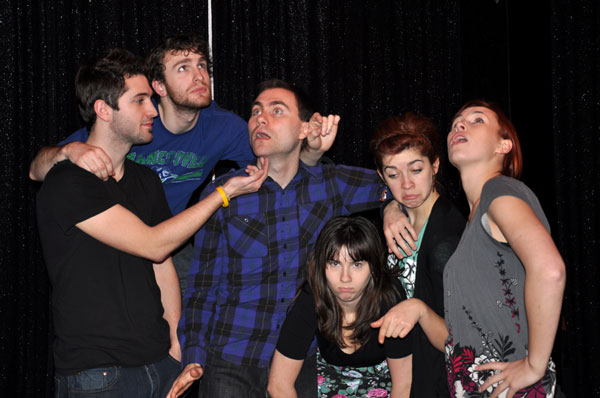
Members of Unscripted Chaos, from far left Blake Cuthbertson, Luke Johnson, Andrew Job, Tracy Schut, Rachelle Tomm and Jessie Crabbe strike a natural pose. (Photo by Miranda Gathercole)
A new improv group has taken hold of the Heritage Gill, bringing a mix of laughs and occasional head-shaking to New Westminster on Wednesday nights.
Unscripted Chaos is a group of six acting students looking for a real-life setting where they can practice their classroom skills.
Rachelle Tomm, a Kwantlen student and the youngest member of the group, said being able to interact with a live audience is a rewarding experience that just can’t be matched.
“It’s a lot of fun. And when you get a larger crowd out, you just feed off the audience. The audience just works off each other. You get good laughs,” she said.
“And when an audience laughs at a time when you didn’t expect it and you can crack up the actors and get them to start laughing, oh that is golden, golden.”
The group starts the evening with a series of games, which provide rules for each scene. The audience is involved in each skit, and will chose the characters settings, occupations, personalities, themes and so on. Once these key elements are established, the actors make the rest up on the spot.
After a break, the final half of the show usually consists of a longer piece that lasts about 25 minutes.
So far, the audiences of their shows have been locally based, with many hearing about the show by word of mouth. But the group hopes to expand and create a rep for themselves.
“It’s exciting, because we are the founding members of the group,” said Tomm.
“It’s not like we had to audition to get in, so we’re growing with it. We’re learning what not to do some nights and what games worked and what games didn’t, because we don’t have any prior experience or older expertise on it. It’s all new to us.”
She says looking a year from now, anything could be possible.
“Maybe we will be well-known like Laugh Lines, or Granville type shows” she said.
Unscripted Chaos performs every Wednesday at 9 p.m. at the Heritage Grill, 447 Columbia St. in New Westminster.
For more information, visit their Facebook group.
[audio:chaos_group.mp3]
Rachelle Tomm, Jessie Crabbe, Tracy Schut, Andrew Job, Luke Johnson and Blake Cuthbertson talk about their experiences so far as members of Unscripted Chaos.
[audio:speed_walk.mp3]
Andrew Job and Blake Cuthbertson perform a skit.
Peering behind ‘The Show’
April 12, 2011 by Miranda Gathercole · Leave a Comment

Caitlin Butcher holds up a shirt from her collection, Patience For Now. The blue in the iris of the eye has been hand-dyed. (Photo by Lucas Meneses-Skoda)
After all the glamour and glitz displayed on the runway of The Show 2011, a fashion show produced by fourth-year fashion students, it’s hard to imagine the tears and sweat that made went into making the garments so fabulous.
In fact, there’s an entire years worth from a class of 32 students.
Caitlin Butcher, one of these fourth-year students, said the amount of preparation that goes into such an event is incredible.
“There’s so much to do and so little time,” she said.
The Show is the end product of the entire fourth year of the fashion design and technology program at Kwantlen Polytechnic University.
From September until April, students learn all aspects of what is needed to run a clothing line and a fashion show in the real world. They begin by creating a niche market and designing three complete outfits. The most important part of this step is proving that this niche exists and is underserved in the fashion world.
“A lot of people come into the program thinking ‘Oh, I love clothes, and I like to draw clothes’ and that’s kind of where I was in first year. I didn’t have much experience in the industry,” she said.
But by the time fourth year comes around, this all changes.
Everything becomes real-life based. If the instructors do not think your niche is developed enough, you have to repeat fourth year. It’s as simple as that.
“It can definitely get a little crazy,” Butcher said.
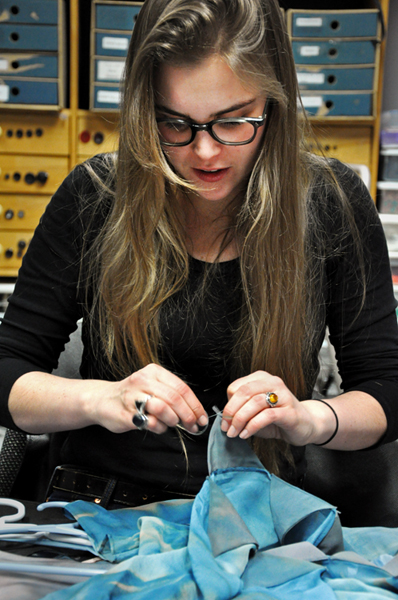
Caitlin Butcher sews a missing button back onto a hand-made slip before displaying it on a mannequin. (Photo by Lucas Meneses-Skoda)
The next step is hand-sewing each garment, a process which can take months.
Butcher created her pieces for “women working in the creative field.” She describes them as fun investment garments for artists and musicians.
With 11 separate pieces in the collection, Butcher said the most surprising thing for her has been “the details that go into producing garments, especially for production.”
“Before I came into the program, I used to make clothes for myself and would cover up any mistakes, and little holes, but I can’t do that anymore,” she said.
Her line, titled Patience For Now, is “a reminder to myself to take it slow and be patient.” Mistakes can happen and as she has learned, and freaking out is not always the best option.
She said one of her worst moments was during an assignment to make tailored coats for The Bay. Butcher had spent 80 hours sewing the garment and, just as she was finishing it, her arm slipped and she ripped a hole in the lining. Everything had to be re-done.
“It’s those kinds of frustrating things that bring you to tears,” she said.
In the end though, Butcher says it is all worth it.
“The process is always so fun, and actually seeing the final product when it becomes tangible — that is so rewarding,” she said.
“It starts as this little idea in your head and then you go through all these motions and it’s tons and tons of work and lots of sleepless nights and sometimes tears when things don’t work out, but it’s just really rewarding.”

Caitlin Butcher has sketched out complete outfits for her line, Patience For Now. (Photo by Lucas Meneses-Skoda)
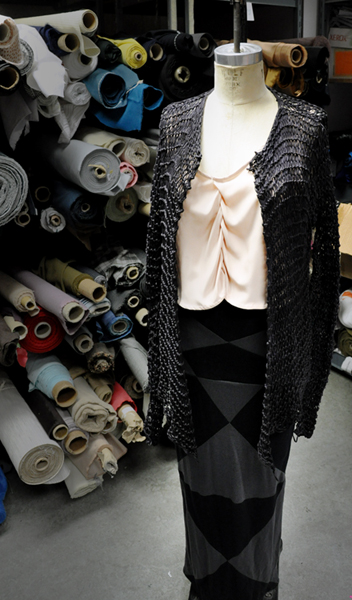
A complete outfit designed and made by Caitlin Butcher. The sweater has been hand-knitted and hand-dyed. (Photo by Lucas Meneses-Skoda)
RELATED: High fashion night after months of hard work
High fashion night after months of hard work
April 12, 2011 by Stu Gallacher · Leave a Comment
The runway before The Show 2011. (Photo by Brittany Tiplady)

Anticipation and sense of excitement were palpable before the Design, Fashion and Technology program had its end of the year show on Tuesday, April 5, at the River Rock Casino in Richmond.
Months of hard work led up to the 45-minute fashion show, said Joanna Delaney, creator of the Vapor line.
“We came up with a concept in the first semester of fourth year, and then the second semester is dedicated to producing the line and making our portfolios,” said Delaney.
“My line is fashion for rainwear…I decided to create a line of raincoats suited to women who are looking for a little something extra, a little bit more than just your average raincoat.”
Delaney said that finding the right niche in such a competitive market takes time, patience and a lot of research. On the business side of things, “You have to prove that your market exists, because you can’t create something for no one,” Delaney said.
Delaney added that her next career step would be to promote herself as an independent designer in the Vancouver.
Justine Edralin, creator of the Menagerie line, said that she started sewing in Grade 8 and her interest in fashion and design grew from there.
“My market is crazy old ladies. I’m really into the avante garde artsy clothing, and also to empathize with a market that’s not myself,” said Edralin.
Edralin says a lot of the thrill of preparing for a show comes from the pressure to get it all done on time.
Alexandria Culver, creator of the Bese Saka line, said that the biggest inspiration for her design was a trip she took to Ghana and West Africa to teach math.
Culver said she was inspired by the prints and that her collection focuses on socially conscious manufacturing. She’s been sewing her collection for the last four months, but they spent fall designing a collection and also creating a company.
Culver said that everyone in the class is supportive, because everyone knows how much work goes into the design process.
Modeling a piece from the Fluid Motion line created and designed by Alisha Leong. (Photo by Brittany Tiplady)

“The show is beneficial for all the students…The program has such a high profile in Vancouver and the industry is aware,” said Culver.
Evelynn May, on of the design coordinators, said there’s so much more to what the audience sees than what meets the eye.
“They’ve done a thesis. They’ve had to argue and validate all their piece collections, because they are niche market collections,” said May.
“It’s been stressful, and it’s all absolutely beautiful,” said May.
Families, friends, and designers peruse student portfolios before the Show begins. (Photo by Brittany Tiplady)

RELATED: Peering behind The Show
Vancouver journalist helping university students with guidebook
April 12, 2011 by Kyle Benning · Leave a Comment
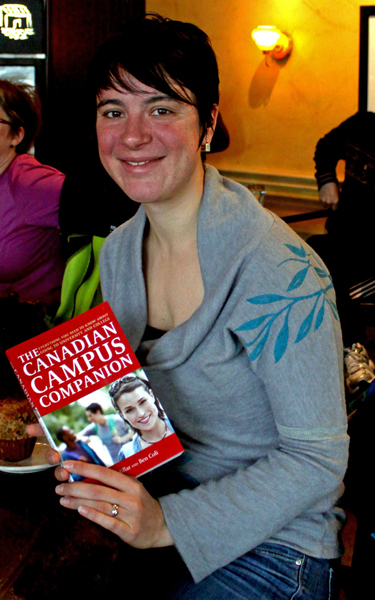
Erin Millar knows too well what it is like to adjust to the post-secondary lifestyle. (Photo by Kyle Benning)
Going into college, Erin Millar thought she was going to be a music teacher.
Now, the Capilano graduate has written The Canadian Campus Companion, a guidebook on going onto post-secondary education in Canada.
The freelance journalist was president of Canadian University Press (CUP) during her time as an editor at the Capilano Courier.
“I really enjoyed [writing] and found my real calling [in journalism],” Millar said.
Millar, who generally writes feature stories, was the first person in her family that attended a post-secondary institution, and she said she learned a lot about the university lifestyle when she moved away from home.
”I remember I moved from Penticton to Vancouver for the first time when I was 18 years old, like everybody else does. It was really challenging. I didn’t know how to do anything. Cap doesn’t have residence, so I had to move into my own place,” Millar said.
“I didn’t even know enough about registering to realize that I had to register myself for English 100. I just sort of assumed I’d show up and I would go to my classes and my program was very set because I was in a very specific program. I didn’t even get all the classes I needed in my first year because I didn’t really realize the process,” Millar said.
Millar co-wrote the book with Ben Coli, her husband, whom she met in Thailand while doing freelance journalism.
“[Coli] went to business school at U of C and worked for a couple years as a property tax consultant and realized that what he really wanted to do was write,” Millar said. “I think we both kind of came at it from other sides, and I think that message is very much in the book to keep your ears open and follow what you really enjoy and it doesn’t necessarily have to be what you expect.”
Millar and Coli got the book deal two days before their April wedding. They started writing the book late, and their deadline was set for Sept. 30 so they could have it on shelves for this spring.
“I feel like the book is a lot better having written it together,” Millar said.
She said that there aren’t many university guidebooks for Canadian institutions and that her book, The Canadian Campus Companion, is the most in-depth university guidebook in the country.
After graduating, Millar found that her passion for writing and journalism was more tempting than a career as a music teacher. She was hired to work full-time by McLean’s Magazine helping with the on-campus website and the university rankings.
Even though she didn’t follow through with her original dream to teach music, Millar keeps her alto saxophone and piano close to her. Millar and her sister are part of a cover band that has been together for seven years.
Bright lights, big screen: Vancouver’s Pacific Cinematheque a safe haven for independent filmmakers
March 10, 2011 by Amanda Punshon · Leave a Comment

Jim Sinclair has been bringing the best of Canadian art-house and independent cinema to the big screen for 20 years as the executive director of Vancouver's Pacific Cinematheque. (Photo courtesy of Pacific Cinematheque)
New technology has made it cheaper and simpler to make films, but with so many indie films floating around on the Internet, it’s hard to get noticed.
That’s where theatres such sa Vancouver’s Pacific Cinematheque come in.
Jim Sinclair, who has been the theatre’s executive director since 1991, said that Pacific Cinematheque’s mandate is to show innovative, artist-driven work.
They accept unsolicited submissions, which are then screened by Sinclair, who decides whether they are good enough to be screened and whether there will be an audience for them. As with films submitted to film festivals, those shown at the Cinematheque are not required to be rated by Consumer Protection B.C.
In the past, this meant that films screened at the Cinematheque were not subject to censorship, Sinclair says. Nowadays, because of the Internet and because ratings are less strict, that’s less of a concern.
But not needing to be rated is still a good thing for filmmakers. It’s not the filmmaker who pays to have their movie rated, it’s the distributor. If they don’t have a distributor, they have to absorb the costs themselves.
And getting your film rated isn’t cheap. According to the Consumer Production B.C. website, each copy of a film that is to be screened has to be rated. In B.C. it costs $12 for the first 10 minutes of the first copy, and then $1.20 for each subsequent minute. For a 90-minute movie, that’s $108. Each additional copy costs half of that ($54 dollars for a 90-minute movie).
But Sinclair says that it’s the culture of the Cinematheque that makes it such a great place for independent and non-mainstream film.
“There’s a whole world of cinema out there that if you relied entirely on what was playing at the multiplex, not only would you never see it, you’d never know it existed,” he said. “Our whole culture, our mandate here is geared toward providing access to the great achievements of Canadian and international cinema, and being a cultural organization that programs that work.”
Sinclair had some parting advice for filmmakers.
“Try hard. It’s work. If you have something that’s good, you need to get people to see it,” he said. “There’s nothing self-effacing about calling up people who curate film or program cinemas and letting them know that you have a film and getting into their hands so they can see it.”
Instant Theatre: a quick education in improv comedy
March 9, 2011 by Amanda Punshon · Leave a Comment
Amanda Punshon and Brian Russell take a look at long-form improv comedy from the perspective of Instant Theatre, a improv team and school that has been around since 1994. The giggles, guffaws and great on-the-spot comedy that the group is known for are all here, including interviews with Instant Theatre’s artistic director Alistair Cook and one of the group’s performers, Brynn Peebles.
Chapel Arts, an unorthodox use of a chapel
February 28, 2011 by Sarah Casimong · Leave a Comment
Despite being a chapel, Chapel Arts has nothing to do with worship unless the subject of praise is the art displayed throughout the building.
When Chapel Arts first opened as a venue three years ago, the words on the window read: “If nothing else believe in art.”
“I’m just not religious,” said Nathan Wiens, owner of Chapel Arts. “I was raised in a family filled with artists and stuff, so I guess that’s what I believe in. I believe in makers instead of The Maker.”
What was once known as the Armstrong Funeral Chapel was owned by the Armstrong family for 103 years, according to Wiens. He bought the chapel in 2005, in what he calls “an accident.”
While searching for a space to make art and furniture, Wiens found a building across the street from the chapel. He was forced to buy the chapel in order to get the shop, as the two buildings had to be bought together. His intial intention was to sell the chapel, but he soon fell in love with its charm and set out to get a licence from the city to open it as a venue.
“That was a very long, educational process,” said Wiens. “[It] took about 22 months to get a licence from the city of Vancouver. They’re very strange. Bureacracy is a very strange thing.”
He claims it was the biggest challenge he faced.
“It cost as much money to wait for them as it cost to buy the real estate. It’s a long time to hustle for a simple business licence that isn’t a change of use but they decide to make it one. So it’s sort of disappointing.”
Once he got the chapel, Wiens renovated it as if it was still 1936, when the chapel’s was expanded, in order to keep its historical feel.
Since getting the licence, the chapel’s been successfully hosting events that include performance art, theatre, concerts, government meetings, conferences, workshops and movie work.
He compares the chapel to “a house party” when it hosts events. The chapel makes most of its money hosting family and corporate parties.
“I believe that everyone’s living in very small places so having an intimate venue like this, that has a homey feel, is kind of attractive to people.”
Although the unorthodox use of space and cozy feel attracts people, being located in the Downtown Eastside turns some people away but Wiens says that’s not always a bad thing.
“The neighbourhood’s a bit tough, but I like the neighbourhood, I don’t have a problem with it. It keeps a lot of people that wouldn’t really appreciate the place away. So it’s a self-screening process. But it keeps a lot of money way, so it’s a bit of both, there are pros and cons.”
Despite the cons, he manages to appreciate the history that comes with the chapel and the neighbourhood it’s a part of.
“It’s a bit tough in just this zone but I don’t think that will change,” said Wiens. “I think the ratios of the demographics will change. There will be less low-income housing in this neighbourhood in the future. It’s the oldest part of the city. It’s the beginning of Vancouver right here. This is where Vancouver started, right here.”
He has high hopes for the chapel and what it will continue to contribute to the Vancouver’s art community.
“I think it will just increase in success with the community,” said Wiens. “I think it’s gonna, whether it’s me running it or not, it’s gonna be around a long time as a public venue that will probably have a good arts base to it. I hope to hang onto it but one never knows.”
Visit chapelarts.com more information.
Swapping the office for a more colourful picture
February 13, 2011 by Amanda Punshon · 2 Comments
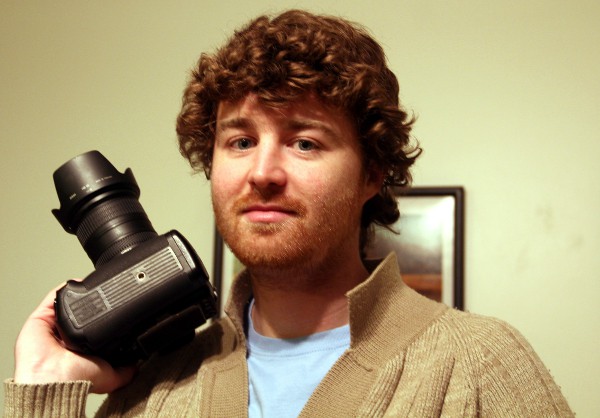
Mark Feenstra quit his office job to pursue a career in fashion photography. (Photo by Sarah Casimong)
At first blush, it seems like something out of a Hollywood movie. Just over a year ago, Mark Feenstra quit his day job as an inventory analyst for Mountain Equipment Co-op in Vancouver to pursue more creative endeavours. If it were a movie, his decision would have been a spur-of-the-moment, dramatic impulse that caused his doting girlfriend no end of financial and emotional distress.
“It really wasn’t a last-minute decision or impulsive thing. There was definitely some soul-searching that went into that,” said Sarah Pawliuk, Feenstra’s girlfriend of two years. “I wasn’t freaked out that it was going to be a big disaster because he’s a really responsible and almost overly-thinking person.”
Feenstra described his position at MEC was a “stepping-stone job,” the kind of job people take when they’re looking to move up in the company.
“One day, I realized that I didn’t want to be where I was going next,” he said. “I loved everything about the company except what I was actually doing when I was sitting at my desk.” So he started making plans to leave the company. He saved money for over two years before he actually quit.
“I knew I needed to make a change while I was still young enough to do that easily. You can do it an any age, but I don’t have kids, I don’t have a mortgage. Now is a pretty good time to take on a high-risk endeavour.”
Feenstra said that he initially took time off to work on his writing. He went to Costa Rica for three months to surf and get himself into a “more creative headspace.”
When he came home, he realized that fiction writing wasn’t going to pay the bills. Even if he wrote the next great Canadian novel, found an agent and a publisher, it would still be at least two years before he earned any money.
“Rather than go back to work this year, like I had originally planned, I’ve decided to use that incredible, gripping fear of having to go back to an office to kind of push me into photography and trying to make a living at it,” he said.
Photography had been a passion of Feenstra’s for as long as he could remember. It was a hobby he shared with his mother, a cancer researcher-turned-biology teacher. He still has the nearly 30-year-old Nikon SLR camera he grew up using.
Feenstra is science-minded – another thing he inherited from his mother – and mechanics of operating a camera really appealed to him. “It’s kind of a way for me to approach more artistic endeavours but still have an element of control,” he said.
Another thing that appealed was the way photography forced Feenstra to step outside himself.
“I hate public speaking, I hate having to show up and meet strangers. Even just going to a party where I don’t know that many people, I get weird anxiety before I have to go. Yet I really want to shoot people. I like portraits, I want to do fashion photography, these are the things I want to do. And I’ve lately just been throwing myself into these scenarios where I don’t know anybody,” he said. “It always turns out to be these amazing experiences.”
Shyness isn’t the only thing Feenstra struggles with.
“One thing that still hasn’t gone away with writing or photography is just huge creative fear barriers. That kind of feeling that you’re not good enough, that you shouldn’t be doing this, that you don’t deserve it,” he said. “At the end of the day, the biggest challenge is just getting over my own inhibitions and just kind of feeling like I shouldn’t be doing this and doing it anyways. And getting through that every time has probably been the biggest challenge. Everything else, when it actually happens, is easy.”
But he sees the challenges as being an important part of the creative process.
“If you’re not a little bit scared of not pulling something off, then you have to question how worth doing it is,” Feenstra said. “If you’re trying to be creative and you’re trying to do something interesting or something that other people can interact with, then you have to be going out into at least your own unknown a little bit. Because if it’s just too easy, then why should anybody else be interested?”
Feenstra wants to break into fashion photography, in part because there are some fairly lucrative career opportunities in the industry, but also because it allows photographers to be creative.
“You flip through magazines, some of the stuff is just garish and awful, and you don’t know how anybody would publish something just so hideous and weird. But it’s great that that’s what somebody got to do,” he said.
He hopes to have his own studio one day, but his dreams are both bigger, and smaller, than that.
“I’d love to be ‘that guy’ in Vancouver where, when celebrities come through town, it’s like, ‘Oh, can we get Mark Feenstra to come in and shoot for the day?’ And I think it’s important to always keep that in mind and believe — act — as though that’s where you’re headed. I think it’s really important to pick a completely and seemingly unobtainable goal, and everything you do should build a foundation to get you in that direction,” he said.
Feenstra said he sees himself as being on the road to his dream, but he’s not hung up on achieving it as soon as possible.
“There’s a certain level of general fashion photography and editorial work that I’d be very happy with for a very long time. I don’t have to get up there, but that’s the general direction. And still, the really important thing for me to do is not get lost in that, and doing everything just commercial work.
“[I want] to pursue some of those personal creative projects without monetizing them,” Feenstra said. “If I want to take a couple months off to go shoot tribes in Borneo without trying to make a lot of money and be worrying who to sell that to, that would be a great place to be.”
Feenstra is not one of those people that’s putting himself all over the Internet in hopes of making a little money. But he is confident that he will eventually turn his passion into a lucrative career.
“If you have a good product, people will find you,” he says.
If you’d like to see samples of Feenstra’s work, you can visit his profile site at www.markfeenstra.com.
The art of bonsai guitar making
February 6, 2011 by Jocelyn Gollner · 1 Comment
There’s no doubt Cal Thompson is an original.
Wearing rolled-up jeans and an I Heart NYC t-shirt, he fits the description of laid-back musician. But there’s something different about him: he makes bonsai guitars.
Bonsai guitar is a name he has given to the instruments that he makes, which look like regular-sized guitars, but miniatures. Thompson estimates that he has made over 400 bonsai guitars.
Some of these instruments can be found hanging from hooks on the wall in his apartment, running the entire length of the main wall. Other guitars are or have been in the hands of famous musicians, ranging from Link Wray to Paul Hyde.
Asked who the majority of his customers are, he says that he gives most of them away to children.
“I really don’t care all that much about money, much to the chagrin of my wife and everyone else around me.”
His band, Little Guitar Army, also performs with many of his bonsai guitars.
Thompson said that the sound from a bonsai guitar, in comparison to a regular-sized guitar, is “a little bit higher, but on all of my records, no one can tell they’re not full-sized guitars until they see us play live.”
[audio: bonsai.mp3]
Click to hear Thompson play one of his bonsai guitars
The History
When Thompson was seven or eight years old, his uncle gave him a guitar.

A Motorhead VIP pass is shown on one of the bonsai guitars. Many members of the band Motorhead have Thompson's guitars. (Photo by Meagan Gill)
“I immediately knew that that was it. That was my first love, my first marriage. I’ve devoted myself to it, regardless of what anyone thinks, tells me or feels,” he said.
Apart from loving the music itself, he also became interested in the mechanics of guitar building. He had grown up around his father’s cabinet shop doing woodworking, so he learned some of his skills from there.
“I started doing it when I was really young,” Thompson said. “I think I came across a ukelele and decided that I could put the same things that were on a big guitar on a little guitar.”
Years later, he was taught instrumental construction by Michael Dunn, a guitar builder from Vancouver, who taught at Douglas College. Dunn says that Thompson was a good student.
“The proof is that he’s still out there making instruments. It wasn’t for everyone. It’s not an easy thing to do. It’s tough,” Dunn said.
Thompson also worked for Jean Larrivee, another well-respected guitar builder in Vancouver. It was there that he had the idea of making bonsai guitars from materials that people were throwing away.
Larrivee “was throwing stuff out and I thought there was so much waste. So I started taking everything that he was throwing out and taking it home. I built a lot of instruments on what people were throwing out.”
Even now, each time he needs materials for a guitar, he’ll scavenge alleys and trash bins in an attempt to find something usable. Thompson said that thriftiness runs in his family.
“My grandfather was a real handy fellow. He didn’t have much money and he had all these responsibilities. So if he needed something, he would come up with something or just do without…My father is the same way.”
About 90 per cent of the materials he uses to build his guitars have been thrown out by somebody.
The Process
His building process starts with a design. He’ll sit at his wooden kitchen table and sketching. Once he has something that he likes, he doesn’t mess around with the design much anymore.
“I’m pretty much done when I know that something is right,” Thompson said.
Next he’ll use math to figure out things like the scale length and how far apart the frets are going to be on the guitar. Then he collects his materials.
Once Thompson has designed, planned and gotten his materials, the building begins.
“I have a checklist in my head that I do. So I’ll make the bodies and make sure that they’re fine. Then I’ll make the necks. And I’ll marry the necks to the bodies. I make sure that they are going to function sonically and be comfortable.”
After that, he worries about the esthetics of the guitar.
“I worry about how they sound and how they feel,” Thompson said. “They can sound really good but if they are uncomfortable to play, then no one is going to make good sound on them.”
The time it takes for him to make a bonsai guitar varies. He has built one in as little as a day and a half, but he has yet to finish a guitar he started building in 1988.
It costs Thompson roughly $600 to make a guitar, but says that some of the guitars that he makes are worth upwards of $3,000.
Thompson has made hundreds of guitars, but he doesn’t feel like he has perfected his craft.
“If I come out with something that is even close to the essence of what I had in my head, I’m satisfied with it,” he said. “And the older I get, the closer I get. It’s never been perfect, and I doubt it ever will, but the older I get, the closer it gets.”
Each guitar is precious to him. Ask him which is his favourite guitar, and he’ll look shocked.
“It’s like asking what one of your children is your favourite! Yeah, probably deep down in my psyche I do [have a favourite], but I’ll never tell a soul. I’d probably feel guilty about it.”

A portion of the bonsai guitars at Thompson's apartment are displayed on one of the walls. (Photo by Meagan Gill)
What now?
“It’s a compulsion more than I’d like to say,” he said. “When I can make a living out of it, I do. But it’s kind of hard to make money out of being an artist.”
He has supported his art by maintaining a variety of other jobs, including carpentry and cabinet-making. Right now, he is thinking about working in a local guitar factory and a guitar repair shop up the street from his house.
But don’t expect to find him playing or crafting full-sized guitars anytime soon.
“Why do someone else’s thing, when I can do my own thing?” he asks. “It’s a hard road, mind you. If you do something that differs, in any culture or subculture, I find that people want you to conform. And if you don’t, my god. You will be called all sorts of names and you’ll find all sorts of barriers that are put up by people trying to be individuals. It’s really quite hard. It’s not easy.”
But continue he will; it’s his love.
Kwantlen’s unknown ‘soldiers’ battle it out on the ‘net
January 30, 2011 by Max Hirtz · Leave a Comment
To the majority of Canadians, the CSL is the Canadian Soccer League, the top soccer league in Canada with a history going back to 1926.
To a small population of video game enthusiasts, the CSL is the Collegiate StarLeague, a younger, lesser-known league of 144 university teams spread across Canada and the U.S. that duke it out online every week, playing a computer game called StarCraft 2: Wings of Liberty.
The four-year-old StarLeague describes itself on its website as a “small step in the process of creating enough excitement and passion for e-Sports to fill stadiums, be broadcast on television, and ultimately become a part of mainstream culture.” Originally a StarCraft league, it switched over to StarCraft 2 when that game was released.
Like most sports organizations, it’s made up of different divisions, eight in all. Kwantlen is in the Guardian division with Queen’s University, the University of Cincinnatati, the University of Georgia and 15 other colleges. UBC, UVic, Thompson Rivers University, BCIT and SFU also have teams.
Seasons start in the fall and end in the spring with playoffs. Last year’s winner was UC San Diego.
The coordinator for Kwantlen’s first-ever StarLeague team is a second-year crimonology student named Jayson Bulahan.
He discovered the StarLeague on an online StarCraft forum and, after realizing what Kwantlen was missing, began trying to organize a squad for this year’s season. It was tough getting into the swing of things, but today Kwantlen’s team consists of 14 players.
Although it is a competition, Bulahan insists that having fun is their priority. If a team member doesn’t want to play, he or she doesn’t have to. Inexperienced players are welcome, too, as long as they’re willing to learn.
“My recruitment standards are not really high. If you’re new, that’s fine. Everyone will get a chance to play,” he said.
Team member Kevin Shen shares Bulahan’s ideology, and finds that it’s “much easier to improve if you’re under that mindset, and if I lose the game, it wouldn’t bother me so much since I can always watch and analyze the replay without feeling ashamed.”
Shen is in his third-year at Kwantlen and first started playing StarCraft in 1998.
Harold Keech, another veteran who’s been playing since 1999, plays mostly for fun but also finds it “very rewarding to win and perform well for the school.”
Although the main goal is to have a good time, Bulahan admits that games can become competetive.
“StarCraft is a game of wits, and I don’t think anyone wants to be outwitted by another player,” he said. “It’s up to the players. It’s their own motivation that drives them to play as best as they can.”
Bulahan said the toughest game the team has played so far was against the University of Southern California.
“We got outplayed by them, and there was nothing we could do,” he said.
That was back when the team was still getting the hang of things, but their skills have improved since then.
“It’s taken us a little bit more time to get used to how we’re supposed to do things,” he said, but added that the team’s getting better every week.
StarCraft 2 — the sequel to the successful 1998 sci-fi game StarCraft —was released in July 2010 and has quickly become one of the most popular and competitive online games. It sold three million copies in the first month and has received universal acclaim from game critics.
It takes place in the 26th century and contains three species — the Terrans, the Protoss and the Zerg — who battle each other in outer space environments.
Kwantlen’s next game is Saturday, Feb. 5 against the University of Minnesota, Twin Cities.

